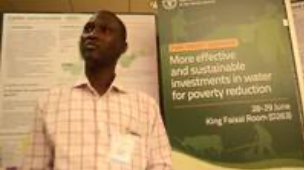Best Practices > Details
Crop-Growth Models Supporting Optimal Solutions For Climate Change Adaptation
19/01/2022 , Amman

The Near East and North Africa (NENA) region has the lowest per-capita fresh water resource availability among all regions of the world and in the coming decades, it faces a severe intensification of water scarcity as well as more frequent, intense and long droughts.
The agriculture sector will be particularly affected, as wheat yields, olive tree yields, and numbers of livestock are projected to decline under all climate change scenarios. Given that agriculture consumes 85 percent of fresh water, the agricultural industry will need to enhance its water efficiency and productivity. At the government level, policy reform could be effectively oriented to encourage the adoption of farm practices that increase adaptation to climate change and enhance resilience.
To address these issues, FAO implemented the ‘Climate Change and Adaptation Solutions for the Green Sectors of Selected Zones in the NENA Region’ project with special focus on Egypt, Jordan and Lebanon. The project used state-of-the art climate change projections, and AquaCrop, FAO’s model for crop yield response to water and climate change, to assess changes in yield of key crops in selected NENA countries under various climate scenarios. The aim was to provide evidence for a regional dialogue and strategic thinking about adaptation responses necessary for coping with the challenges of climate change, water scarcity and food security.
 Interview with Abdou Rhamane Jobe,Ministry of Agriculture, Gambia
Interview with Abdou Rhamane Jobe,Ministry of Agriculture, Gambia
Abdou Rhamane Jobe from the Ministry of Agriculture of the Gambia, presents the benefits that the analysis on the impacts of climate change on crop yields using the AquaCrop model will bring to his country.
 The crop-water productivity model (AquaCrop) is developed by FAO’s Land and Water Division to address food security and assess the effect of the environment and management on crop production.
The crop-water productivity model (AquaCrop) is developed by FAO’s Land and Water Division to address food security and assess the effect of the environment and management on crop production.
AquaCrop simulates the yield response crops to water and is particularly well suited to conditions in which water is a key limiting factor in crop production.
Aquacrop in Central and West Africa
Similar approach has been used as well in Côte d’Ivoire, Gambia, Niger, Mali presents the benefits that the analysis on the impacts of climate change on crop yields using the AquaCrop model. This analysis is carried out in the framework of
the project "Adapting Small Scale Irrigation to Climate Change in Central and West Africa".

Aquacrop helped with climate impact assessment of Kenya’s Tea sector’ followed by a formulation of a climate smart strategy. Tea is Kenya’s principal agricultural industry, employing over 2 million people. And the continued viability of the sector is critical to Kenya’s rural economy and the livelihood of 500 000 farm families.
The economic analysis covered the tea value chain, market structure; sources of competitiveness and comparative advantages; the sources of technical progress that ensured Kenya’s continued tea productivity improvements that kept the country among
the world top producers and exporters of tea.
AquaCrop for optimal irrigation calendars: the case of sugarcane in Senegal
 The “Compagnie Sucrière Sénégalaise” (CSS) was looking for a decision support tool to improve their productive water management. With almost unlimited water resources from the Senegal river for its around 13.000 ha of
irrigated sugar-cane, the company wanted to economize their water(and pumping) consumption, and act as a responsible and exemplary water manager for the region. Through AquaCrop simulations, different water related stresses were observed and after
calibration and validation an optimal and easy applicable irrigation calendar was developed and almost 4000 mm of irrigation water saved for a 100% relative biomass production.
The “Compagnie Sucrière Sénégalaise” (CSS) was looking for a decision support tool to improve their productive water management. With almost unlimited water resources from the Senegal river for its around 13.000 ha of
irrigated sugar-cane, the company wanted to economize their water(and pumping) consumption, and act as a responsible and exemplary water manager for the region. Through AquaCrop simulations, different water related stresses were observed and after
calibration and validation an optimal and easy applicable irrigation calendar was developed and almost 4000 mm of irrigation water saved for a 100% relative biomass production.
In general, there is a need to demonstrate the value of water-limited yield predictions to policy makers that must be operational under water supply constraints, aggravated in the event of a drought. AquaCrop is essential for determining water productivity
gaps thus allowing the identification of factors that may contribute to enhancing the efficiency of water use.
Find out more
- AquaCrop
- Climate Change and Adaptation Solutions for the Green Sectors of Selected Zones in the NENA Region’ project
- The Arab Climate Change Assessment Report,
- Regional Initiative for the Assessment of Climate Change Impacts on Water Resources and Socio-Economic Vulnerability in the Arab Region (RICCAR).
- "Adapting Small Scale Irrigation to Climate Change in Central and West Africa".
- Climate Impact Assessment of Kenya’s Tea sector
- The AquaCrop model – Enhancing crop water productivity
